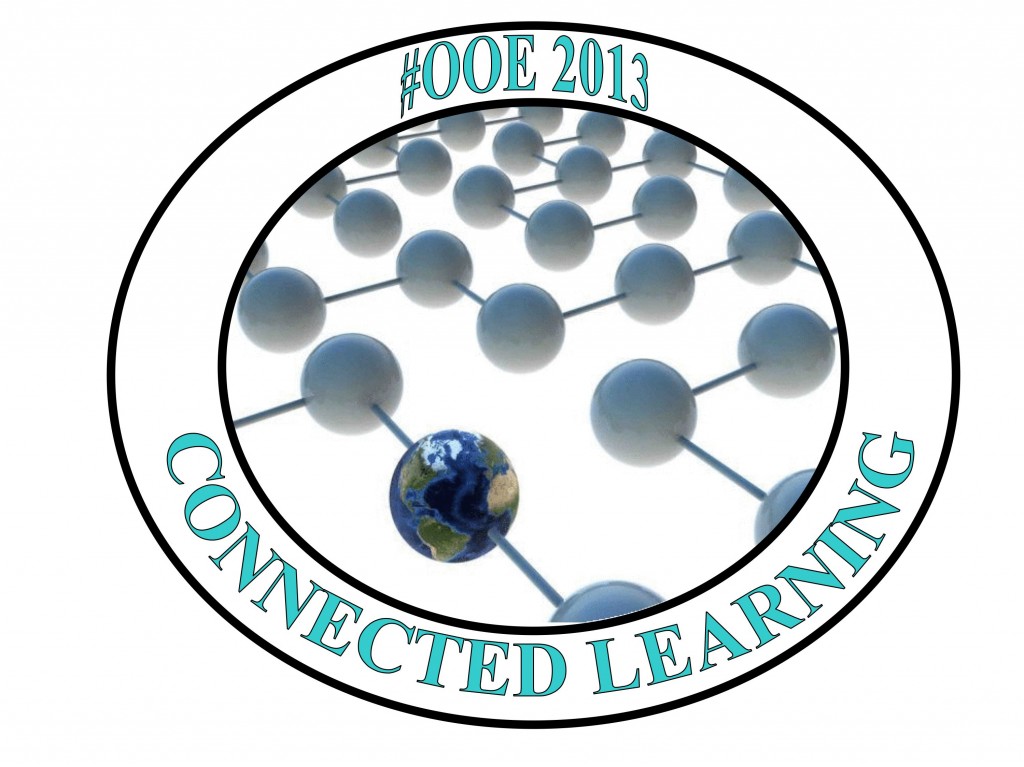
OOE13 image, by Glenn Hervieux. Check out the OOE13 site at http://www.ooe13.org
In a few short weeks, a new open online course will begin, called #OOE13, Open Online Experience 2013(-2014). It is designed as a profession development experience in educational technology for educators, but it is open to anyone who would like to participate. It starts September 4, 2013.
I am one of the many, many people who have helped to shape this course, and who will be helping to run it. And I mean many! There are probably 50 or 60 people who have contributed in one way or another! It has been (and I expect will continue to be) a great experience in collaboration.
I’m writing this post, though, to encourage others to join #OOE13, by noting its similarity to a course I did in January-March 2013, and which had a profound impact on me professionally and personally. It’s not exaggerating to say it changed my life in many ways. Those of us who are working together to make #OOE13 happen are hoping that will be the case for many of the participants as well.
I’ll first describe a bit about ETMOOC and why I found this experience so valuable–the point here is that we have designed #OOE13 similarly, hoping that others will also have a great experience. So in describing ETMOOC, I’m also giving you a flavour of #OOE13.
So please read on and see if this sparks your interest, and if so, you can register for #OOE13 here!
ETMOOC
What I took in Jan-March 2013 was ETMOOC (Educational Technology and Media MOOC): http://etmooc.org
This was a connectivist-style MOOC (massively open online course) (see my post on what I think a “connectivist MOOC” means), run by a large group of people from many different professions and educational institutions. It lasted for ten weeks or so, and every two weeks there was a new theme relating to educational technology (Connected Learning, Digital Storytelling, Digital Literacy, The Open Movement, and Digital Citizenship). You can see more about each of these topics at the ETMOOC main site, which has posts explaining some aspects of each topic and giving resources, on the front page (just scroll down).
To be quite honest, I wasn’t sure about joining this course, because I wasn’t terribly interested in educational technology. But I had heard of “connected learning” and the “open” movement, and wanted to learn a bit more about those; plus, the structure of the course seemed interesting. So I tried it.
Structure
Each week there would be one or more presentations on BlackBoard Collaborate that you could join live from anywhere in the world, or watch the recording later. We had guest speakers from various parts of the world on these topics (though all English-speaking). Then we had suggested other things to read/watch/do each week. We were highly encouraged to reflect on what we were seeing/reading/doing in our blogs, which were connected to a blog hub–so you could easily find blog posts from each person in the course. We also were encouraged to comment on each others’ blogs during the course, to get conversations going that way.
In addition, we had a one-hour chat on Twitter each week, on the #etmchat hashtag. I hadn’t used Twitter much before that, and didn’t realize how effective Twitter chats can actually be. You may think you can’t get much done in bursts of 140 characters, but I was surprised at how rich and effective the discussion was at times. Here is a record of our chat on digital literacies, and here is one on open education (best to scroll all the way down to the very beginning and start there, b/c it’s in backwards chronological order).
Freedom to participate how and when you want/can
One very nice thing about ETMOOC was that there was no pressure to continue through the whole course, or to do all the activities. It was clear there was an open door to come in and go out when you wanted, and to do as much as you wanted. This felt freeing, for the times when I just got too busy. And since the topics changed every two weeks, new people could start with a new topic and there wasn’t a sense that they needed to go back and “catch up” on anything.
What I did in ETMOOC
I’ve got a couple of records of what I did in ETMOOC, in case anyone is interested. First, I’ve got quite a few blog posts I wrote during ETMOOC, which can all be found by clicking on the “Etmooc” category on the right menu.
I also put together a more connected narrative of what I did in ETMOOC, which can be found here on my blog.
Why I found ETMOOC so valuable
[Update Aug. 22: Of course, I should say that I got quite a lot out of ETMOOC in terms of learning things about educational technology, connected learning, digital literacy, digital storytelling, and more, but honestly, the things that really struck me, that are most meaningful for me, are those mentioned below.]
1. Making Connections –that’s the best way for me to think of putting it, but it can sound more crassly self-interested than I mean. By making connections I mean that I found many people in different parts of the world who are interested in similar things as I am in terms of teaching and learning, and whom I can now talk to long after the course is done. This is great, because it means having a group of people you can engage in discussions with about, not just educational technology, but pedagogy generally.
For me, it’s like when I go to a teaching/learning professional development workshop and meet interesting people and talk to them about pedagogy and get great ideas…except when that happens it all ends when the workshop ends. Sure, we could meet up again, but we’re all busy and usually that doesn’t happen. But with an online course like this, the connections and discussions seem easier to keep up. I’m not sure why, but that’s been my experience. I can do it from home, on my own time, talking to people on Twitter, on blogs, on Google+, or other social networking sites. We don’t have to schedule a meeting to be somewhere face to face at the same time (though sometimes we try to schedule video or audio chats on Skype or Google Hangouts, because we do want to talk in real time; even then, it’s easier because we don’t have to get to the same location).
A number of us found these connections so valuable we started a “post-etmooc” group on Google+, in which we read blogs or online journals and discuss them. We also have Twitter chats. And this is all after the course is long finished!
Beyond that, I’ve “met” (through online means such as blogs, Twitter, Google+, Google Hangouts) many, many people whose work I continue to read on their blogs, who I continue to talk with on Twitter, and who share helpful links with me about pedagogical topics we’re interested in (and vice versa!).
What this means is I’ve developed an online Personal Learning Network––a network of people from whom I learn and who learn from me (here’s a nice, in-depth video explaining PLNs, and here’s a shorter one with people’s views of why they find them valuable). It’s a group that talks about things related to teaching and learning generally, and includes K-12 teachers, higher ed faculty, educational technology specialists, businesspeople, and more. We not only share links of interest, but we ask questions of each other, support each other when there difficulties, offer advice/suggestions, and more. I have found this of immense value professionally–and personally! Over time some of these connections have developed into friendships, even before we have ever met in person.
And several of these connections have turned into professional collaborations on other projects, such as #OOE13 itself. A number of ETMOOC participants have gotten together to plan #OOE13, modeling it in large part on ETMOOC, and hoping to share what has been a great experience for us, with others.
2. Changing my professional activities
Since doing ETMOOC I’ve begun to focus my professional research and activities much more on things I had never even heard of before, such as open education, connectivist MOOCs, blending on-campus courses with an open online component, making digital audio and visual media for courses and having students make them as well, and more.
I decided a couple of months ago to create a mind map to show all the things I’ve begun to do as a result of ETMOOC, just to try to explain how much it has affected my professional life. You can see it here. It’s pretty self-explanatory!
#OOE13
We’ve designed OOE13 with the same basic structure as ETMOOC, and, as you can see from the list of topics (scroll down on this page), a similar content focus. We’ll have guest speakers doing synchronous presentations (which will be recorded for later viewing), Twitter chats, a Google+ group, and we’ll encourage people to post on their blogs and comment on those of others.
Time: September to May
The main difference is that we’ve designed #OOE13 so that teachers and faculty could participate more easily during busy teaching terms. This means spreading the course out over an entire academic year (September to May) rather than having it be 10-12 weeks.
The reason we did this is so that people have more time to watch recorded presentations if they couldn’t be there live, and to write blog posts/comment on posts from others. If there is a lot to do from week to week and people feel like they can’t keep up because they are busy, they may be less motivated to continue–even though we will stress, like ETMOOC did, that you don’t have to do everything, and it’s fine to move in and out! So instead of new topics every two weeks, we’ll have new topics each month.
Flexible
You can join in anytime and leave anytime, whatever suits you. I found I got a lot out of ETMOOC by being pretty active for most of the time, but that may not suit your schedule. If you want to just watch some presentations, that’s fine! If you want to blog about them too and comment on others’ blogs, that’s great–and you may make connections in the process! If you want to join in the Tweet chats, go ahead…even if you’re not doing anything else in the course.
Drop in to the topics that interest you…leave for awhile and come back…it’s up to you.
Badges
Some schools connected to #OOE13 have programs where they will earn professional development credit for doing the course, but for others who don’t have that option (and for any participant, actually), we’re creating badges you could earn. We’ve got a few already, but will be adding to this set as the course goes along.
There really is little to lose and potentially a lot to be gained, so why not give #OOE13 a try? Take another look at the website, and if you’re interested, sign up here!
Hope to see you there…




